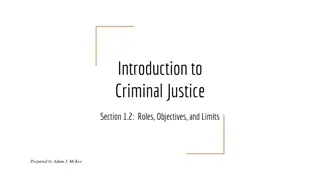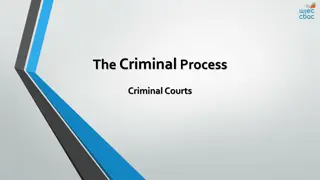Stages of Criminal Justice Process in Cases Involving Women
The stages involve arrest, referral to relevant authorities, decision-making by police and prosecution, assessment for problem-solving approach, court proceedings, and potential sentencing for women aged 16 and over. The process includes early intervention, referrals, assessments, and possible prosecution, emphasizing problem-solving approaches for suitable cases.
Download Presentation

Please find below an Image/Link to download the presentation.
The content on the website is provided AS IS for your information and personal use only. It may not be sold, licensed, or shared on other websites without obtaining consent from the author.If you encounter any issues during the download, it is possible that the publisher has removed the file from their server.
You are allowed to download the files provided on this website for personal or commercial use, subject to the condition that they are used lawfully. All files are the property of their respective owners.
The content on the website is provided AS IS for your information and personal use only. It may not be sold, licensed, or shared on other websites without obtaining consent from the author.
E N D
Presentation Transcript
Stage 1: Arrest to First Calling Police Police make make early early arrest arrest referral to referral to CJSW CJSW CJSW CJSW assess if assess if case is case is suitable suitable for for PSA PSA Police make Police make custody decision custody decision Police Police make make decision decision to to proceed? proceed? Yes Offence Offence committed by committed by women 16 and women 16 and over over Police make Police make arrest arrest or or Police release on Police release on undertaking undertaking CJSW CJSW flags case to case to COPFS COPFS marking marking team if team if suitable for suitable for PSA PSA flags or or Case proceeds Case proceeds as cited case as cited case Police opt Police opt to make to make referral to referral to Priority Priority Famillies Famillies Referral Referral to to COPFS COPFS No Case ends Case ends Notes: In co-accused cases, where it is deemed suitable for a woman to be referred for problem solving, she will benefit from being offered an early diet and taken through the problem solving process. Even if the co-accused fails to make an appearance in court, the woman s case will still proceed to trial/sentencing and as normal even if there are delays with the co-accused diets.
Stage 1: Arrest to First Calling Continued Referral Referral to to COPFS COPFS COPFS receives COPFS receives report report COPFS marking COPFS marking First First calling calling Yes COPFS COPFS decision decision to to proceed? proceed? No COPFS prosecutes COPFS prosecutes Case ends Case ends COPFS deploys COPFS deploys direct measures direct measures
Stage 2: First Calling to 1st problem solving hearing (plea) Finding of not guilty Early diets fixed Early diets fixed where the woman is where the woman is on bail on bail Case proceeds Case proceeds Case ends Case ends Change of plea to guilty/Finding of guilty Not Guilty Sentence Sentence deferred deferred for rapid for rapid report (to report (to PSC PSC within within 1 week) 1 week) Report Report sent to sent to problem problem solving solving sheriff sheriff Referral Referral to to CJSWD CJSWD Yes Assessment by Assessment by CJSW CJSW Deferred Deferred sentence sentence hearing hearing Report by Report by CJSW CJSW First First calling calling Plea? Plea? Guilty Note: After the woman pleads, the procurator fiscal depute will advise the problem solving sheriff if she is suitable for problem solving
Stage 3: Problem Solving Process Case ends Case ends Progress Progress reports reports (Structured) Deferred sentence or Community Payback Order with PSA intervention and case management package Compliance acceptable Fine/admonition/ discharge The day before each review Case management Case management Deferred Deferred sentence sentence hearing hearing Decision Decision sent to sent to CJSW CJSW Complia Complia nce nce Problem solving Problem solving hearing review hearing review Decision Decision s? s? Sentencing Sentencing decision? decision? Interventions Interventions Custody Compliance not acceptable Enforcem Enforcem ent ent reports reports Case ends Case ends Sheriff Sheriff deploys deploys appropriate appropriate measures measures























